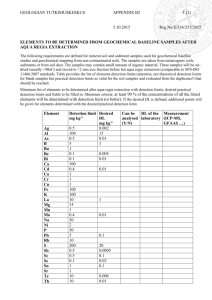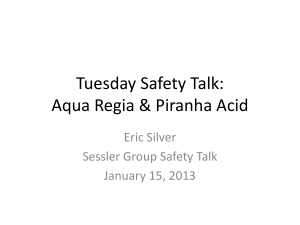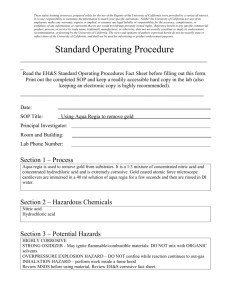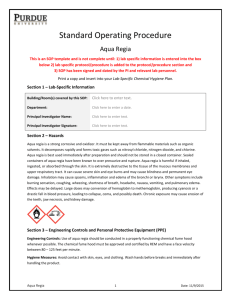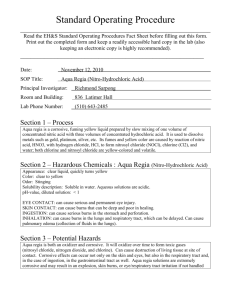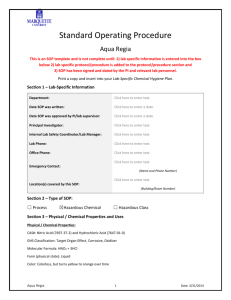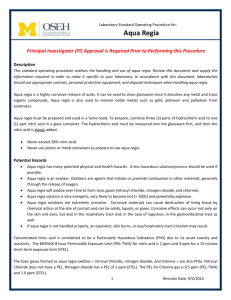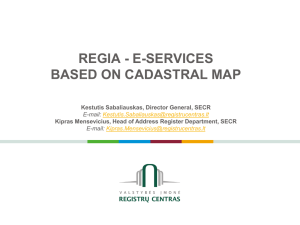Aqua regia
advertisement
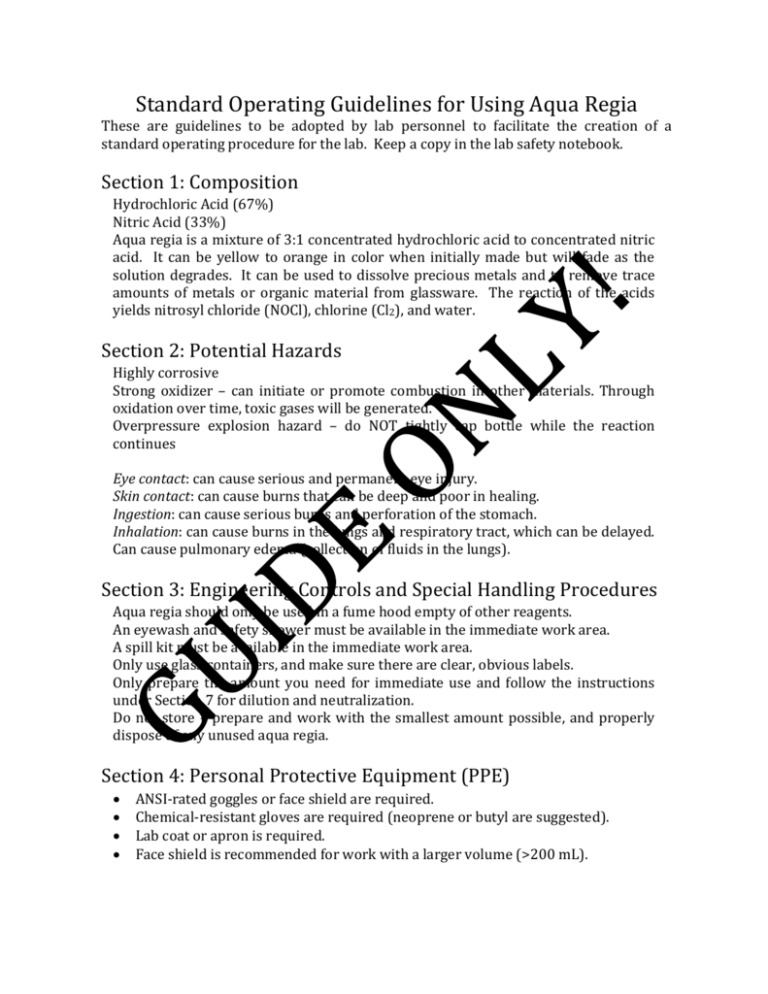
Standard Operating Guidelines for Using Aqua Regia These are guidelines to be adopted by lab personnel to facilitate the creation of a standard operating procedure for the lab. Keep a copy in the lab safety notebook. Section 1: Composition Hydrochloric Acid (67%) Nitric Acid (33%) Aqua regia is a mixture of 3:1 concentrated hydrochloric acid to concentrated nitric acid. It can be yellow to orange in color when initially made but will fade as the solution degrades. It can be used to dissolve precious metals and to remove trace amounts of metals or organic material from glassware. The reaction of the acids yields nitrosyl chloride (NOCl), chlorine (Cl2), and water. Section 2: Potential Hazards Highly corrosive Strong oxidizer – can initiate or promote combustion in other materials. Through oxidation over time, toxic gases will be generated. Overpressure explosion hazard – do NOT tightly cap bottle while the reaction continues Eye contact: can cause serious and permanent eye injury. Skin contact: can cause burns that can be deep and poor in healing. Ingestion: can cause serious burns and perforation of the stomach. Inhalation: can cause burns in the lungs and respiratory tract, which can be delayed. Can cause pulmonary edema (collection of fluids in the lungs). Section 3: Engineering Controls and Special Handling Procedures Aqua regia should only be used in a fume hood empty of other reagents. An eyewash and safety shower must be available in the immediate work area. A spill kit must be available in the immediate work area. Only use glass containers, and make sure there are clear, obvious labels. Only prepare the amount you need for immediate use and follow the instructions under Section 7 for dilution and neutralization. Do not store – prepare and work with the smallest amount possible, and properly dispose of any unused aqua regia. Section 4: Personal Protective Equipment (PPE) ANSI-rated goggles or face shield are required. Chemical-resistant gloves are required (neoprene or butyl are suggested). Lab coat or apron is required. Face shield is recommended for work with a larger volume (>200 mL). Section 5: Storage Requirements Never store aqua regia for later use. Only prepare what you will be using immediately. Only store aqua regia waste in its own glass bottle with the cap LOOSELY on top. The solution will off-gas and could build up pressure and become an explosion hazard if the cap were sealed on tightly. Keep the container in a secondary container in a fume hood empty of other reagents/wastes. Once the waste container is full, tag for waste pickup. Follow disposal procedures. Section 6: Spill and Accident Procedures First Aid measures: Inhalation: Move the exposed person to fresh air at once. Seek medical attention if experiencing respiratory irritation, cough, or tightness in the chest. Symptoms may be delayed. Ingestion: Promptly get affected person to drink large volumes of water to dilute the swallowed chemical. DO NOT induce vomiting. Get medical attention immediately. Never make an unconscious person vomit or drink fluids! Skin: Wash off promptly and flush contaminated skin with water. Promptly remove clothing if soaked through and flush skin with water. Get medical attention if irritation persists after washing. Eyes: Promptly wash eyes with plenty of water while lifting the eyelids. Continue to rinse for at least 15 minutes and get medical attention. Chemical Spill measures: If less than 500 mL of spent solution is spilled in the hood, use the chemical spill kit to clean it up. Once cleaned, tag any contaminated material for waste pickup. If more than 500 L of spent solution is spilled in the hood, OR if any amount of reactive solution is spilled in or out of the hood, OR if greater than 200 mL of spent solution is spilled outside of the hood, call service operations (802-656-2560) to page the safety staff to clean up the spill. Wipe area with sodium bicarbonate solution afterwards. Section 7: Waste Disposal Dilution and Neutralization: All dilution and neutralization should be done in a fume hood and using a stir plate to ensure mixture of the solution. 1. Minimize waste by only preparing as much as will be needed. 2. Collect all aqua regia in a container. 3. Use a secondary container free from all organic chemicals/solvents for the container in which the aqua regia waste will be neutralized. 4. The neutralization container should be glass and large enough to never be more than 2/3 full. 5. Calculate the volume of water needed to make a 7.5x dilution, and add that to the neutralization container. 6. Calculate the amount sodium bicarbonate (or magnesium hydroxide) needed to fully neutralize the aqua regia, and add it to the water in the neutralization container. 7. SLOWLY add the aqua regia waste to the full volume of the basic aqueous solution, while avoiding overheating. Gradually add all of the aqua regia and test the pH of the solution. (The pH needs to be between 5 and 9 for drain disposal.) 8. Allow the solution to cool to room temperature before transferring the solution, moving the container, or capping the container. If the solution contains any of the following metals, the waste must be tagged for pick up: arsenic, barium, cadmium, chromium, lead, mercury, selenium, and silver. If the solution contains any of the following solvents (more than a trace amount), the waste must be tagged for pick up: benzene, carbon tetrachloride, chlordane, chlorobenzene, chloroform, cresol, 1,4-dichlorobenzene, 1,2dichloroethane, 1,1-dichloroethylene, 2,4-dinitrotoluene, heptachlor (and its epoxide), hexachlorobenzene, hexachlorobutadiene, hexachloroethane, methyl ethyl ketone, nitrobenzene, pentachlorophenol, pyridine, tetrachloroethylene, trichloroethylene, 2,4,5-trichlorophenol, 2,4,6-trichlorophenol, and vinyl chloride. If none of these metals or solvents is present, drain disposal may be approved. This needs to be determined before any solution is poured down the drain. Contact EHS or submit an online request. Section 8: Decontamination Rinse contaminated glassware with copious amounts of water. Section 9: Training All personnel are required to complete the general online and classroom safety training courses. Any personnel must review the guidelines here and how to properly handle aqua regia before preparing and using this solution. Lab Risk Assessment or the Chemical Use and Planning Form must be reviewed as well. Section 10: Specific Procedure Description In DETAIL, describe the procedure for either doing the work or making the solution mentioned in Section 1. Specific amounts of reagents should be included where appropriate. This can be a step-by-step guide. Section 11: “What-If Analysis” In DETAIL, examine any foreseeable incidents to help prevent accidents and injuries from occurring. Section 12: Signature(s) of Compliance I have read and fully understand the above SOP. I will adhere to all stated regulations and safety measures when using this chemical. __________________________________ Name (Print) _______________________________________ Signature and Date __________________________________ Name (Print) _______________________________________ Signature and Date __________________________________ Name (Print) _______________________________________ Signature and Date __________________________________ Name (Print) _______________________________________ Signature and Date __________________________________ Name (Print) _______________________________________ Signature and Date __________________________________ Name (Print) _______________________________________ Signature and Date __________________________________ Name (Print) _______________________________________ Signature and Date __________________________________ Name (Print) _______________________________________ Signature and Date __________________________________ Name (Print) _______________________________________ Signature and Date __________________________________ Name (Print) _______________________________________ Signature and Date
